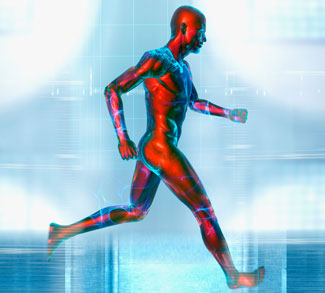Now we have bionic eyes and limbs, and chemists are creating artificial bodily tissues to rival nature's own, as Jon Evans discovers
In Short
Electronic and mechanical limb and organ replacements are already being tested on humans
Chemists and biochemists are developing artificial versions of bodily organs and tissues
US chemists have developed artificial collagen which improves on natural fibre
Carbon nanotubes make a promising artificial scaffold on which to build stronger bones
In playgrounds around the world during the 1970s, children could be seen running in pretend slow-motion while making a 'na-na-na' noise. This was all due to a US television programme called The six million dollar man, which detailed the adventures of a former astronaut called Steve Austin (played by Lee Majors).

Chemists are helping to reignite the dream of creating a bionic man
© LEND IMAGES / ALAMY
Austin had been seriously injured in a plane crash and then 'rebuilt' in the eponymous, rather expensive operation. This replaced his right arm and both legs and his left eye with bionic implants that gave him enhanced strength, speed and vision, and he subsequently became a secret agent. In the programme, whenever Austin employed his super speed or strength, he was shown in slow motion accompanied by an electronic grinding sound, hence the playground imitation.
Although the idea of building a bionic man was quite clearly fantastical in the 1970s, it is increasingly becoming a realistic possibility. This was showcased last year at the Experimental Biology 2006 meeting in San Francisco, US, which included a symposium entitled 'The $6 billion (hu)man'.
Besides highlighting a quite shocking rate of inflation, this symposium also demonstrated the advanced state of much of the current work on bionic implants. For instance, William Craelius from Rutgers University, US, unveiled the Dextra bionic hand system, which uses a patient's existing nerve pathways to control individual computer-driven mechanical fingers. Meanwhile, Daniel Palanker from Stanford University, US, presented his recently designed bionic eye. This consists of a wallet-sized computer processor, a solar battery and a small light-sensing chip implanted in the eye, and a tiny video camera mounted on virtual-reality style infrared goggles. Since then news of a US woman fitted with the world's first bionic arm has been widely reported. The arm was developed by a medical team from the Rehabilitation Institute of Chicago, US. And in February this year, researchers from the University of Southern California, US, unveiled plans for a human trial of a bionic eye which is surgically implanted into the retina.
All the bionic technologies presented at the symposium and reported in the press are electronic or mechanical devices designed to replace bodily limbs and organs. They are therefore realistic versions of the bionic implants given to Steve Austin, although they tend to be fairly bulky and most of them aren't designed to provide enhanced speed, strength or vision.
But these kinds of devices are now not the sole option available for 'rebuilding' a person, because chemists and biochemists have also been busy developing artificial versions of bodily organs and tissues.
This work has evolved out of efforts to fix damaged organs and tissues by stimulating cell growth within patients. For instance, a number of research groups have developed ways to incorporate bodily cells inside some kind of scaffold, such as a polymer hydrogel. The idea is that, once implanted inside a patient, the cells incorporated in the scaffold will grow and reproduce, while the scaffold gradually gets broken down. Eventually, the cells grow to replace the damaged tissue and the scaffold disappears.
Other researchers have wondered whether they could grow entire organs or large sections of tissue in the laboratory and then implant them into patients. This, in turn, has led others to contemplate developing improved versions of bodily tissues and organs, which would be tougher and stronger than the natural variety. Could this eventually lead to the development of a real-life Steve Austin?



No comments:
Post a Comment